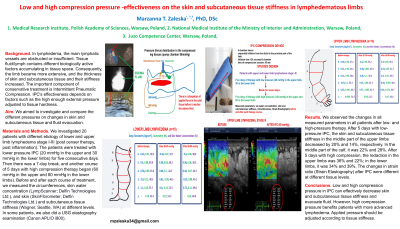Clinical Research
(CR-062) Low and high compression pressure -effectiveness on the skin and subcutaneous tissue stiffness in lymphedematous limbs.

In lymphedema, the main lymphatic vessels are obstructed or insufficient. Tissue fluid/lymph contains different biologically active factors accumulating in tissue space. Consequently, the limb became more extensive, and the thickness of skin and subcutaneous tissue and their stiffness increased. The important component of conservative treatment is Intermittent Pneumatic Compression. IPC's effectiveness depends on factors such as the high enough external pressure adjusted to tissue hardness.
We aimed to investigate and compare the different pressures on changes in skin and subcutaneous tissue and fluid evacuation.
Methods:
We investigated 20 patients with different etiology of lower and upper limb lymphedema stage I-III (post censer therapy, post inflammation). The patients were treated with lower pressure IPC (20 mmHg in the upper and 30 mmHg in the lower limbs) for five consecutive days. Then there was a 7-day break, and another course of 5 days with high compression therapy began (60 mmHg in the upper and 80 mmHg in the lower limbs). Before and after each course of treatment, we measured the circumferences, skin water concentration (LympScanner; Delfin Technologies Ltd.), and skin (SkinFibrometer; Delfin Technologies Ltd.) and subcutaneous tissue stiffness (Wagner, Seattle, WA) at different levels. In some patients, we also did a USG elastography examination (Canon APLIO i800).
Results: We observed the changes in all measured parameters in all patients after low- and high-pressure therapy. After five days with low-pressure IPC, the skin and subcutaneous tissue stiffness in the middle part of the upper limbs decreased by 20% and 14%, respectively. In the middle part of the calf, it was 22% and 28%. After five days with high compression, the redaction in the upper limbs was 36% and 22%; in the lower limbs, it was 34% and 39%. The changes in strain ratio (Strain Elastography) after IPC were different at different tissue levels.
Discussion:
Conclusions. Low and high compression pressure in IPC can effectively decrease skin and subcutaneous tissue stiffness and evacuate fluid. However, high compression pressure benefits patients with more advanced lymphedema. Applied pressure should be adjusted according to tissue stiffness.

.jpeg)